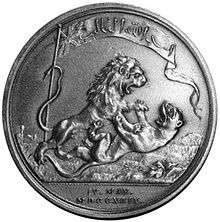Seringapatam medal
| Seringapatam medal (ಶ್ರೀ ರಂಗ ಪಟ್ಟಣ) | |
|---|---|
|
Obverse and reverse of s silver Seringapatam medal | |
|
Awarded by | |
| Type | Campaign medal |
| Awarded for | participation in the Battle of Seringapatam |
| Statistics | |
| Established | 1801 |
| Total awarded |
50,000+ 350 gold 185 silver gilt 850 silver 5,000 bronzed 45,000 tin.[1] |
|
Ribbon bar | |
The Seringapatam medal (Sri Ranga Pattana - ಶ್ರೀ ರಂಗ ಪಟ್ಟಣ), commissioned by the East India Company in 1801, was a Conrad Heinrich Küchler-designed military medal distributed to those soldiers who contributed to the British victory in the 1799 Battle of Seringapatam against the armies of Tipu Sultan, ruler of the Kingdom of Mysore.[2] Many of the medals were manufactured at the Soho Mint in Birmingham.[3] A smaller version of the medal was manufactured in the Calcutta Mint.[4]
Notably, medals were issued to all participants, although their materials were of various values.[3] Those given to the highest-ranking commanders were made of gold, those given to intermediate ranks were silver, silver-gilt, or bronze, and those given to lesser ranks were made of tin or possibly pewter.[1][4]
The reverse of the medal displays the storming of the fort, with the sun at its meridian. The obverse shows the British lion trampling Tipu's emblem, the tiger,[3][2] with the caption "Asad Allah al-Ghalib" (Arabic: أسـد الله الـغـالـب, "Lion of God the Conqueror").[5]
See also
References
- 1 2 Steward, William Augustus (1915). War Medals and Their History. S. Paul. pp. 10–13.
- 1 2 "The Seringapatam Medal". The Victoria and Albert Museum. Retrieved 27 November 2014.
- 1 2 3 "Seringapatam Medal (Gold)". The Fitzwilliam Museum. Retrieved 27 November 2014.
- 1 2 "Seringapatam Medal 1799.". National Army Museum. Retrieved 27 November 2014.
- ↑ Maya Jasanoff (2007). Edge of Empire: Lives, Culture, and Conquest in the East, 1750–1850. Random House. ISBN 978-0-307-42571-3.
| Wikimedia Commons has media related to Seringapatam medal. |

